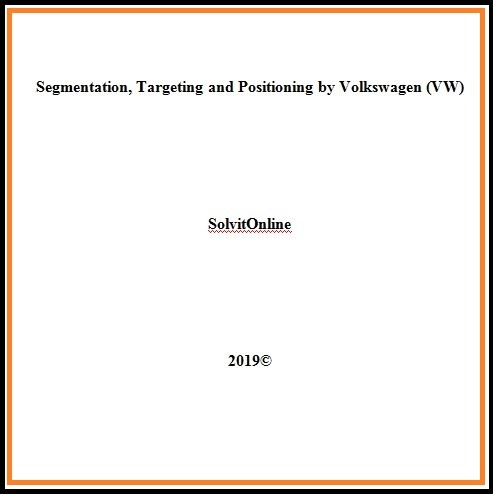 This article presents a segmentation targeting and positioning strategy example. It also presents a segmenting targeting positioning example. It discusses market segmentation of cars and stp model marketing example, and is related to market segmentation for car industry, automotive market segments, automotive market segmentation, and marketing stp:
This article presents a segmentation targeting and positioning strategy example. It also presents a segmenting targeting positioning example. It discusses market segmentation of cars and stp model marketing example, and is related to market segmentation for car industry, automotive market segments, automotive market segmentation, and marketing stp:
- Psychographic segmentation of automobile industry
- Geographic segmentation of automobile industry
- Demographic segmentation of automobile industry
- Behavioral segmentation of automobile industry
The article basically attempts to answer the question how do car companies segment their market (focusing on Volkswagen)? Article preview:
Segmentation, Targeting and Positioning by Volkswagen
Introduction
Many successful companies across the world apply segmentation, targeting and positioning (STP) as part of their marketing strategies. Volkswagen (VW), a company that makes cars is one of the successful companies that apply STP. Established in 1937, the company manufactures several car brands including Audi, Seat, Lamborghini, Skoda, Porshe, Scania, Man, Bentley, Bugatti, and Volkswagen (Volkswgen, 2018a; Bhasin, 2017; Volkswagen, 2018b). While its headquarter is in Wolfburg, Germany, the company has several branches and plants spread out in different parts of the world. This enables it to meet the needs of its global clientele, with the help of a robust distribution network. This paper briefly discusses segmentation and targeting before focusing on how Volkswagen has segmented its market, its target markets (segments), and how the brand is positioned.
Related Article: Market Segmentation, Targeting & Positioning (STP) with Company Examples
Segmentation and Targeting
Market segmentation, according to William Stanton, is the process of dividing the heterogeneous market for a product into several sub-markets or segments, each of which tends to display homogeneity in all important aspects (Rudani, 2010; Tabavar n.d., p. 63). Philip Kotler, on the other hand, defines segmentation as the process of dividing a market into discrete groups of buyers based on factors such as needs or characteristics, behaviour, marketing mixes, or who might require different products (Rudani, 2010). A company’s market can be partitioned or divided based on different factors. Some of the bases commonly applied in segmenting a market are demographic characteristics (such as age, gender, religion, income levels, family size), behavioural characteristics (such as brand loyalty status, usage rates/consumption levels, benefits sought by the buyer, response to a product, and occupation), geographic characteristics (such as geographic location, cultural preferences, language, population type and density (urban, rural, exurban, suburban), time zone, and climate/season, and psychographic characteristics (such as values, beliefs, interests, attitudes, lifestyles, personality traits, social status).
Targeting, according to Bihani (2004), is the process of evaluating how attractive market segments are and choosing the segment(s) to enter. It involves making choices taking into consideration available and necessary resources. Firms have a number of options with regard to the targeting strategy to apply. The main targeting strategies that companies can apply are mass marketing, niche marketing, segmented marketing, and micromarketing (Strydom, 2005; Kotler et al., 2015).
Segmentation and Targeting by Volkswagen
Volkswagen applies segmented marketing and has its market partitioned based on a mix of psychographic, demographic, geographic, and behavioural factors to meet the specific needs of different groups of customers. The following section discusses Volkswagen’s market segmentation based on these factors/bases. …
Psychographic segmentation involves partitioning a market based on customers’ values, beliefs, interests, attitudes, lifestyles, personality traits, social status, or other psychographic factors. Volkswagen has partitioned its market based on customers’ interests and lifestyles. In this regard, some of the segments the company targets include consumers who simply need mobility, enthusiasts and consumers who need comfort.
The compact or small cars that VW manufactures such as the beetle, polo, and golf are aimed at catering to the needs of consumers who simply need mobility or who simply wish to enjoy the utility value of a car … The cars targeted at these consumers are simple in design, …, and are cheaper to buy and maintain. …
Positioning of Volkswagen/ Volkswagen Brand Positioning
Market positioning, according to Wilkinson (2013), is the process of establishing the identity or image of a product or brand so that it is perceived in a certain way by consumers. … With regard to positioning, Volkswagen takes pride in being a leader in … and to this extent uses the
tagline “….”. … Volkswagen mostly positions itself as … that produces … vehicles which attract … compared to most car brands with more or less similar specifications. Whichever place the Volkswagen car is marketed, it is positioned as a vehicle that promises …
Conclusion
Volkswagen segments its market based on a mix of psychographic, … factors to meet the specific needs of different groups of customers. With respect to psychographic segmentation, the company has segmented its market based on customers’ interests, … and lifestyles. …. The company applies … given that it has segmented its market based on how consumers intend to use vehicles. There are consumers who need vehicles for … use while others need them for …. use. Going by …., Volkswagen positions itself as a …. brand that produces … efficient vehicles. Continue reading …
Related article: Market Segmentation, Targeting & Positioning (STP) with Company Examples
Outline
Introduction
Segmentation and Targeting
– Segmentation and Targeting by Volkswagen
– Psychographic Segmentation
– Demographic Segmentation
– Geographic Segmentation
– Behavioural Segmentation
– Positioning of Volkswagen
– Conclusion
– References
